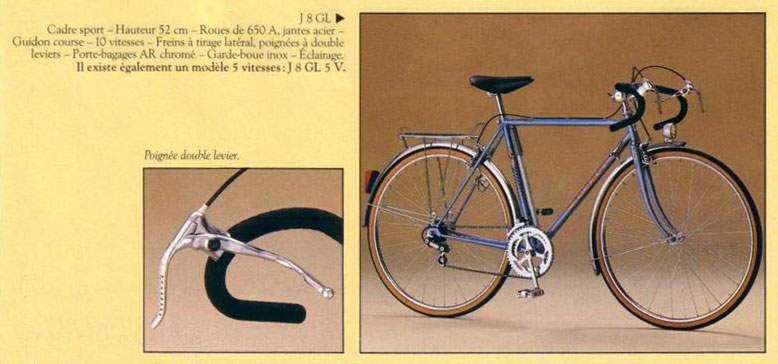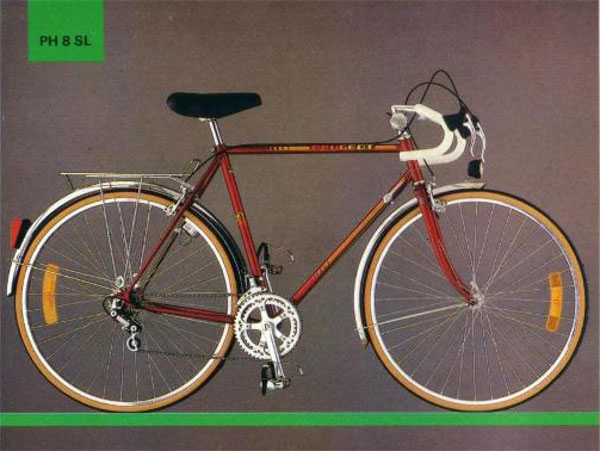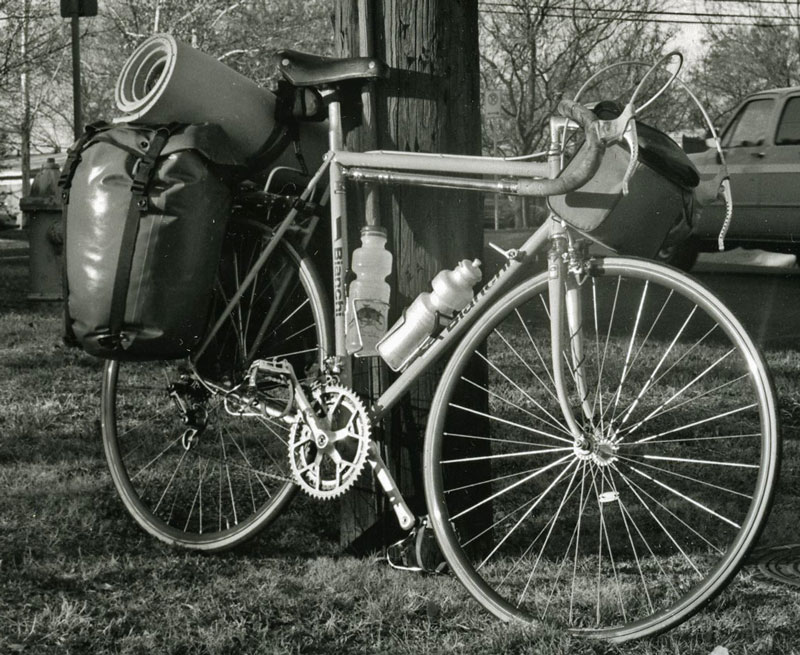A Journey of Discovery: The Lure of Racing Bikes

When we wrote the “A Journey of Discovery” series for this blog, we started with the racing bikes we rode a little over a decade ago. However, my “journey” has been much longer…
I grew up in Germany, where all bikes had fenders, lights and racks. When I was ten years old, I got a bike that was the envy of my friends: a Peugeot “Semi-Racer” with derailleurs, 10 speeds and drop handlebars. It was just like the one shown in the catalog above, except mine was silver. Of course, my bike had a rack and fenders, as well as a sidewall generator that made a huge racket at night. The whole package must have weighed about 35-40 pounds, because most of the parts were made from steel.

My next bike was another Peugeot (above). It was a step up: It had rims and cranks made from aluminum. Of course, it still was equipped with fenders, lights and a rack, and it still was heavy.

Then I went to college, and a neighbor asked me to fix up his brother’s Bianchi racing bike. After overhauling the Bianchi’s bearings and brakes, I took it for a test ride. I was amazed at how different this bike felt compared to my Peugeot. The acceleration was incredible, and it held the road so much better, too. Hills that had been a chore on the Peugeot became an exhilarating experience on a bike that just wanted to go. I decided then and there that I needed a racing bike!
So I saved my money, bought a Campagnolo Victory group on closeout, and soon was the proud owner of a Bianchi “Reparto Corse” frameset, made from Columbus SL tubing. It was a true dream bike. The Campagnolo components gleamed, and their precision was a revelation after the cheap French components of the Peugeot. The performance was in another league, and I promised myself I’d never ride another bike with fenders again!

Even though I had planned to keep the Peugeot for touring, I preferred to strap a rack to the Bianchi for my cross-country trips in Germany. The Bianchi with its short chainstays was not ideal for carrying panniers, but it was much better than the sluggish performance of the Peugeot. I even commuted on the Bianchi, unless the weather was extremely bad. I remember watching my bike during a winter night as I sat in class: The lovely Bianchi was getting covered in snow as huge flakes fell. Fortunately, the snowy roads meant that traffic was light on the way home, because I didn’t have lights on the bike…
When I moved to Texas, I brought the Bianchi, but left the Peugeot in Germany. I ordered a custom Mercian touring bike (below on left), which had racks, but true to my promise, no fenders. Those fenders would have come in handy on my very first tour to Colorado. Every afternoon, we had to find shelter in advance of the daily rainshowers.

When I moved to Seattle, I resisted fenders for two rainy winters, because I didn’t want to go back to the sluggish performance of my childhood Peugeots. When my teammates finally made me put fenders on my bike, I couldn’t bring myself to “compromise” my racing bike. Instead, I equipped my touring bike with fenders, and even on that bike, I took the fenders off every spring.
In retrospect, it’s clear why the Bianchi was such an epiphany. Its Columbus SL frame was much lighter and more flexible than the “drainpipe” I was used to. For the first time in my life, I experienced “planing.” Of course, I still thought that stiffer frames were better, and I tried to explain the superior performance with the more obvious differences: the lack of fenders, lights and racks, plus the skinny tires. The Peugeot was fully equipped and slow, the racing bikes were lighter and thus faster (or so I thought).

It took a whole “Journey of Discovery” to figure out that my dislike of fenders was misguided. I learned slowly and over many years that I could have fenders, lights and racks without giving up the performance of the racing bikes which I loved so much.
To some, it may appear like I have come full circle, and that my current French-inspired bikes are similar to the Peugeots of my childhood. Nothing could be further from the truth. The randonneur machines I ride today (above) really are closely related to the racing bikes that transformed cycling for me. Their lightweight, flexible frames are responsible for their speed, and the fenders, lights and rack simply increase these bikes’ versatility without detracting from their performance.


